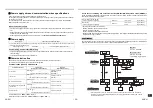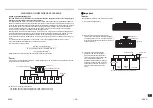
– 34 –
EN
WARNINGS ON REFRIGERANT LEAKAGE
Check of Concentration Limit
The room in which the air conditioner is to be installed requires a design that in the event of refrigerant gas
leaking out, its concentration will not exceed a set limit.
The refrigerant R410A which is used in the air conditioner is safe, without the toxicity or combustibility of ammonia,
and is not restricted by laws to be imposed which protect the ozone layer. However, since it contains more than air, it
poses the risk of suffocation if its concentration should rise excessively. Suffocation from leakage of R410A is almost
non-existent. With the recent increase in the number of high concentration buildings, however, the installation of
multi air conditioner systems is on the increase because of the need for effective use of floor space, individual
control, energy conservation by curtailing heat and carrying power etc.
Most importantly, the multi air conditioner system is able to replenish a large amount of refrigerant compared with
conventional individual air conditioners. If a single unit of the multi conditioner system is to be installed in a small
room, select a suitable model and installation procedure so that if the refrigerant accidentally leaks out, its
concentration does not reach the limit (and in the event of an emergency, measures can be made before injury can
occur).
In a room where the concentration may exceed the limit, create an opening with adjacent rooms, or install
mechanical ventilation combined with a gas leak detection device.
The concentration is as given below.
Refrigerant Concentration Limit shall be in accordance with local regulations.
NOTE 1
If there are 2 or more refrigerating systems in a single refrigerating device, the amounts of refrigerant should be as
charged in each independent device.
For the amount of charge in this example:
The possible amount of leaked refrigerant gas in rooms A, B and C is 10 kg.
The possible amount of leaked refrigerant gas in rooms D, E and F is 15 kg.
Total amount of refrigerant (kg)
Min. volume of the indoor unit installed room (m
3
)
≤
Concentration limit (kg/m
3
)
e.g., charged amount (10 kg)
Outdoor unit
e.g., charged amount (15 kg)
Indoor unit
Room A
Room B
Room C
Room D
Room E
Room F
Important
NOTE 2
The standards for minimum room volume are as follows.
(1) No partition (shaded portion)
(2) When there is an effective opening with the
adjacent room for ventilation of leaking refrigerant
gas (opening without a door, or an opening 0.15% or
larger than the respective floor spaces at the top or
bottom of the door).
(3) If an indoor unit is installed in each
partitioned room and the refrigerant
piping is interconnected, the smallest
room of course becomes the object. But
when a mechanical ventilation is
installed interlocked with a gas leakage
detector in the smallest room where the
density limit is exceeded, the volume of
the next smallest room becomes the
object.
Outdoor unit
Refrigerant piping
Indoor unit
Refrigerant piping
Outdoor unit
Indoor unit
Mechanical ventilation device - Gas leak detector
Very small room
Small
room
Medium
room
Large room
67-EN
68-EN



































